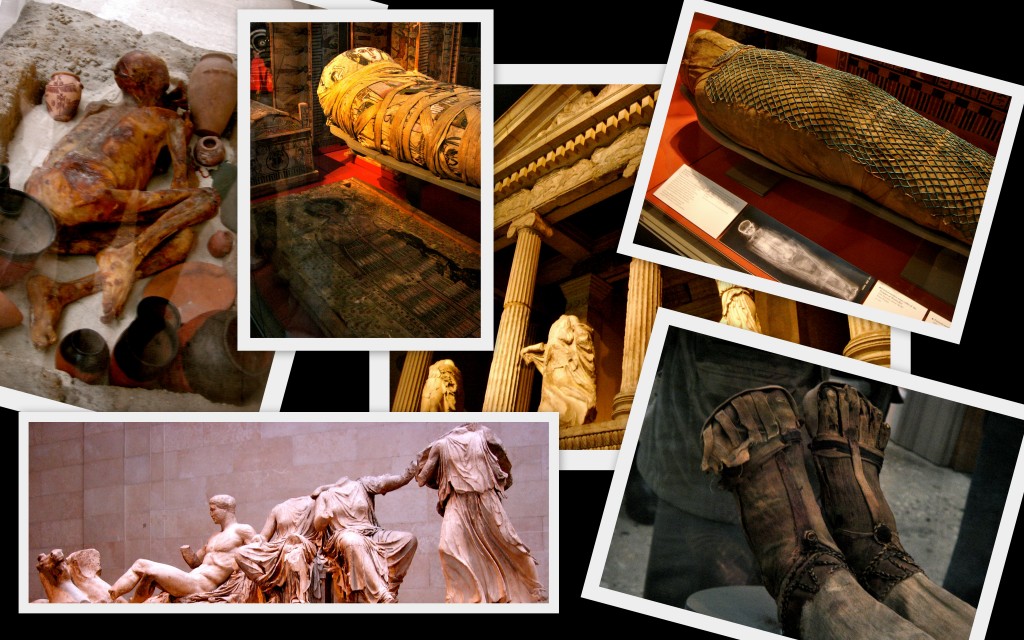
[Author’s note: I am a lover of museums, I enjoy the idea of presenting something for public admiration, yet the following post is a type of critique directed towards museum culture. The questions I pose seek responses and if you can and are willing to I am more than happy to receive responses and to discuss comments and ideas.]
Every civilization constructs themselves in unique ways, develops rituals, cultural symbolisms and folklore depending on the values, morals and believes of either a powerful minority or the general population. When I visited the British Museum today I was at awe at the number of Egyptian objects on display and could not help but to inquire about their present state. I know this is a museum and the point is to display objects of interest to the general public, after all that is how revenue is made and popularity is obtained, the “weirder” the object the more people that want to come see, but why? I realized that museums practice a form of cultural fragmentation, they present to the audience a piece of a culture/civilization, the one that we (as the audience) will be most intrigued by; again, but why? why are we always fascinated with that which is different from the things that we know (as “normal”)? What makes us so superior that we have taken the right to place other cultures on display as if they were commodities? Thousands of years displayed in one room, objects preserved for a lifetime and …mummies on display? Whatever happened to resting in peace?
If Egyptians believed in placing specific objects in the tombs of their pharaohs for the after life then guess what, we have totally screwed up thousands of years of ritualized mummification for the sake of cultural representation. For as silly as this may sound I was a bit saddened to realize that if Cleopatra came back in her after life she would have no wealth, it has been divided among different museums and collectors all overt eh world. Her mummy was assigned a resting place, a burial ground, for a reason, and by removing her from that environment we have damaged the fabric of one of the world’s most intricate civilizations. How dare we disrupt the living dead? How dare we destroy sanctuaries, transport them across the globe, and study them as if they were meant to be objectified in the first place.
Although, I was extremely impressed at the sculptures of the Parthenon (located at the exhibit on Greece at the British museum), once again I asked myself: Why are these magnificent structures here? Why are they not at the Parthenon where they belong? Later in the day I learned from on of my classmates that it’s a complicated history which most of us know nothing of. She explained to me how parts of the Parthenon were being stolen from their original site, and so someone “rescued” pieces in order to preserve what was left of it (these are some of the pieces on display). Ok, just maybe some of the objects displayed are righteously justified, but my questions still stand: why are we always fascinated with that which is different from the things that we know (as “normal”)? What makes us so superior that we have taken the right to place other cultures on display for our own leisure?
The questions rumbling through my mind make me think back on my Workshop in Cultural Analysis class last semester (at Dickinson) where we discussed issues with cultural representation, fragmentation, fetishism, commodity culture, among others. In this class I wrote a paper in which I argued that much of the discourse we know as “truth” (regarding the representation of different cultures) is based on the believes of a powerful minority. In the words of Bell Hooks (author of “Teaching to Transgress” and “Ain’t I a woman,” among others):
Within commodity culture, ethnicity becomes spice, seasoning that can liven up the dull dish that is mainstream white culture. Cultural taboos around sexuality and desire are transgressed and made explicit as the media bombards folks with a message of difference… bringing to the surface all those “nasty” unconscious fantasies and longings about contact with the Other embedded in the secret (not so secret) deep structure … In many ways it is a contemporary revival of interest in the “primitive.”
Even though the quote above speaks better to a more sexualized commodification and/or fragmentation of cultures it is relevant in multiple other ways. As a superpower Britain (as well as the US) have been the “main dish” seeking “spice” to “liven [themselves] up.” Both predominantly “white” civilizations (UK and US) have sought to explore and display the “other” in order to maintain themselves as the “us.”
The questions remain, why display mummies when they were not meant to be exhibited (all over the globe) in the first place?Why do we commodify other cultures, fragmentize them and appraise only a part of them (the part that has been given to us)? Again, every civilization constructs themselves in unique ways, develops rituals, cultural symbolisms and folklore depending on the values, morals and believes of either a powerful minority or the general population. What are we constructing that will be on display a thousand years from now? Would you like to see the complexities of your life minimized to a single cardboard wall (or a short movie clip), on some museum, set up for judgement? Would you like your body to be preserved, put up for auction, displayed on a gallery without your consent? Think about it, how would Cleopatra feel if she was to rise from the dead to tomorrow to find herself in a glass box, on a different continent, far from anything know, separated from her wealth and objects provided to her inside her tomb upon her death?
“A culture is made– or destroyed– by its articulate voices” (Ayn Rand, Russian born American writer and novelist).
